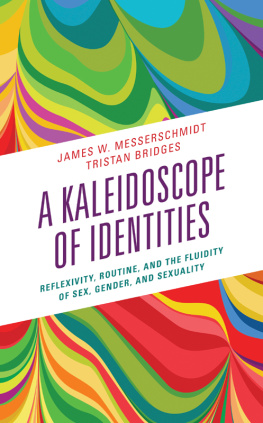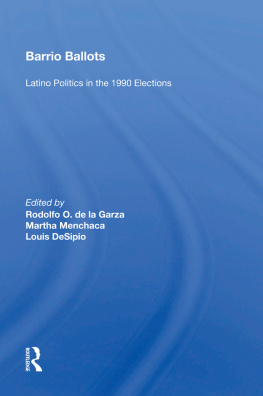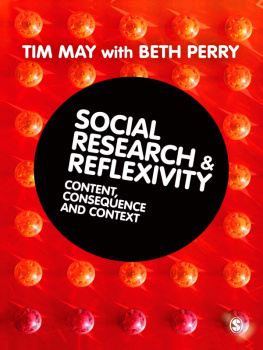Contents
Guide

A Kaleidoscope of Identities
A Kaleidoscope of Identities
Reflexivity, Routine, and the Fluidity of Sex, Gender, and Sexuality
James W. Messerschmidt and Tristan Bridges
ROWMAN & LITTLEFIELD
Lanham Boulder New York London
Published by Rowman & Littlefield
An imprint of The Rowman & Littlefield Publishing Group, Inc.
4501 Forbes Boulevard, Suite 200, Lanham, Maryland 20706
www.rowman.com
86-90 Paul Street, London EC2A 4NE
Copyright 2022 by James W. Messerschmidt and Tristan Bridges
All rights reserved . No part of this book may be reproduced in any form or by any electronic or mechanical means, including information storage and retrieval systems, without written permission from the publisher, except by a reviewer who may quote passages in a review.
British Library Cataloguing in Publication Information Available
Library of Congress Cataloging-in-Publication Data
Names: Messerschmidt, James W., author. | Bridges, Tristan, author.
Title: A kaleidoscope of identities: reflexivity, routine, and the fluidity of sex, gender, and sexuality / James W. Messerschmidt and Tristan Bridges.
Description: Lanham: Rowman & Littlefield, [2022] | Includes bibliographical references.
Summary: This book proffers a new conceptual framework of sex, gender, and sexual identity, presenting data that documents these identities as typical and extensive rather than exceptional. A Kaleidoscope of Identities reveals the more elusive elements of sex, gender, and sexual life which are often difficult to capture in quantifiable variablesProvided by publisher.
Identifiers: LCCN 2022012003 (print) | LCCN 2022012004 (ebook) | ISBN 9781538167861 (cloth; alk. paper) | ISBN 9781538167878 (paperback; alk. paper) | ISBN 9781538167885 (ebook)
Subjects: LCSH: Gender identity. | Sex role. | Sex. | Identity (Psychology)
Classification: LCC HQ18.55 .M47 2022 (print) | LCC HQ18.55 (ebook) | DDC 305.3dc23/eng/20220311
LC record available at https://lccn.loc.gov/2022012003
LC ebook record available at https://lccn.loc.gov/2022012004
 The paper used in this publication meets the minimum requirements of American National Standard for Information SciencesPermanence of Paper for Printed Library Materials, ANSI/NISO Z39.48-1992.
The paper used in this publication meets the minimum requirements of American National Standard for Information SciencesPermanence of Paper for Printed Library Materials, ANSI/NISO Z39.48-1992.
In her article Said and Done versus Saying and Doing: Gendering Practices, Practicing Gender at Work, Martin (2003) argues that practicing gender is an active phenomenon, accomplished quickly, directionally, in interaction with others, and routinely with liminal awareness. For example, she reports on an interaction between Tom and Betsy, both vice presidents in a Fortune 100 company, who stood
talking in a hallway after a meeting. Along the hallway were offices but none was theirs. A phone started to ring in one office and after three or so rings, Tom said to Betsy, Why dont you get that? Betsy was surprised by Toms request but answered the phone anyway and Tom returned to his office. (Martin 2003, 346)
Afterward, Betsy confronted Tom by stating: Im a vice-president too, Tom, and you treated me like a secretary. What were you thinking? Tom responded, I did not even think about it (2003, 346). Martin analyzes how the shape of the unequal encounter was hidden from both participants in the interaction. Although Betsy eventually recognized the inequality, her participation initially remained invisible to her, and Tom did not recognize at all what he did prior to being confronted. Both Betsy and Tom were participating routinely , yet unreflexively , in an instance of a localized, dominating form of ephemeral hegemonic masculinity (Messerschmidt 2018a).
Tom clearly controlled the situation by directing Betsy to answer the phone, and initially, Betsy compliedwith neither, at the outset, recognizing the interaction as gendered. In this instance, the social construction of culturally supported dominating masculine qualities (commanding and controlling) in unequal relation to culturally supported subordinate feminine qualities (obedience and submission) routinely transpires, producing hegemonic masculinity, emphasized femininity, and unequal gender relations. Although Tom and Betsy unintentionally and spontaneously contributed to the construction of gender hegemony (Messerschmidt 2018a), Martin points out that neither engaged reflexively:
They did not analyze the situation; they were practiced in gender; they practiced gender. The gender institution holds women accountable to pleasing men; it tells men/boys they have a (gender) right to be assisted by women/girls; Tom and Betsy knew this. Toms request and Betsys behavior are thus unsurprising. Without stopping to reflect, Tom practiced a kind of masculinity that the gender institution makes available to him, which is to request practical help from women; Betsy responded in kind by complying with his request. (2003, 346)
Toms and Betsys interaction did not require reflexivity because, as Martin argues, Toms request made perfect sense to both (2003, 347). Tom and Betsy engaged in routine gendered social interaction and identity work that did not necessitate deliberate forethought or a reflexive strategy.
Martin argues that routine accomplishments of gender embodied by both Betsy and Tom (the said and done) provided a framework for them to miss this moment in the social construction of unequal relations between them (the saying and doing). For Martin, this example represents gender practice as more routine than reflexive. Yet, she also reports another situation wherein Tom engaged in gender reflexivity . Tom had developed a personal policy that he reflexively followed for thirty years of never having dinner with a woman with whom he works:
Many years ago,... when I first started working, uh, I made a rule to myself that I would never have dinner with a woman alone, just the two of us. And, to be quite honest, I said I never want to be in a position where either I would be tempted, or anyone could come in and see [us] and develop a wrong impression. So, I have breakfast with them [women], and I would have lunch, but I would never have dinner alone with a woman. Just a rule. (Martin 2003, 348)
In other words, through internal deliberation, Tom reflexively developed a gendered rule of refusing to have dinner alone with a woman with whom he is working. The rule demonstrates reflexivity about gender identity and inequality. Yet, Tom assumes his rule protects women (and his own reputation) when in fact it also works to structurally offer women fewer opportunities to network and to build the kinds of professionally close relationships with superiors and possible mentors that could lead to valuable opportunities (e.g., Valerio and Sawyer 2016).
Martins (2003) article is both useful and unusual in defining and differentiating routine and reflexive gender practices. Martins (2003, 2006) work was pioneering in our conception of gender practice, concentrating on what she labeled gender practices and practicing gender. The former refers to embodied practices available in specific social settings for individuals to enact in an encounter or situation in accord with (or in violation of) the gender institution (2003, 354). The latter entails gendered social action often accomplished quickly, directionally (in time), unreflexively, routinely, informed by liminal awareness, and through interaction with others. Although Martin conceptualized practicing gender as more routine than reflexive, she notes that a thorough understanding of gender practice requires attention to agency, intentionality, awareness, and the role of reflexivity in its daily constitution. This book responds to that call by theorizing not simply reflexivity but the symbiotic relationship between reflexivity and routine in the construction of sex, gender, and sexual identities.












 The paper used in this publication meets the minimum requirements of American National Standard for Information SciencesPermanence of Paper for Printed Library Materials, ANSI/NISO Z39.48-1992.
The paper used in this publication meets the minimum requirements of American National Standard for Information SciencesPermanence of Paper for Printed Library Materials, ANSI/NISO Z39.48-1992.